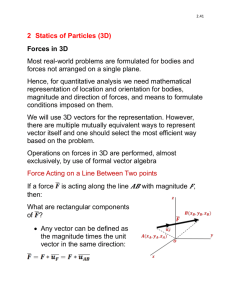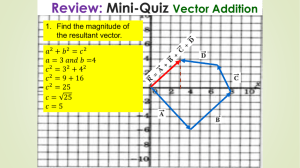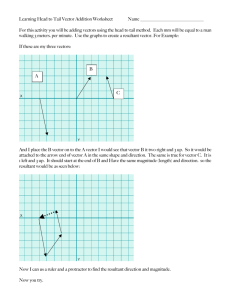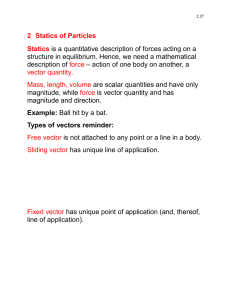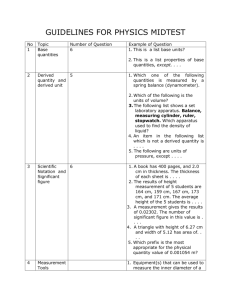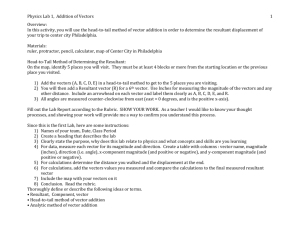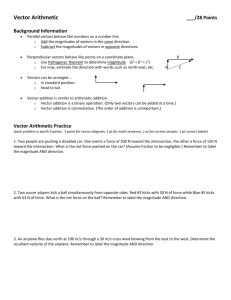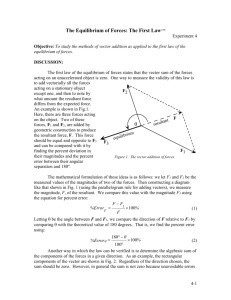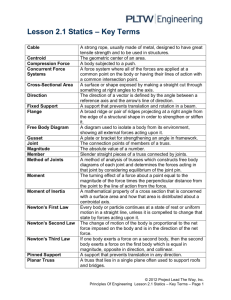Statics of Particles (3D): Forces & Equilibrium
advertisement
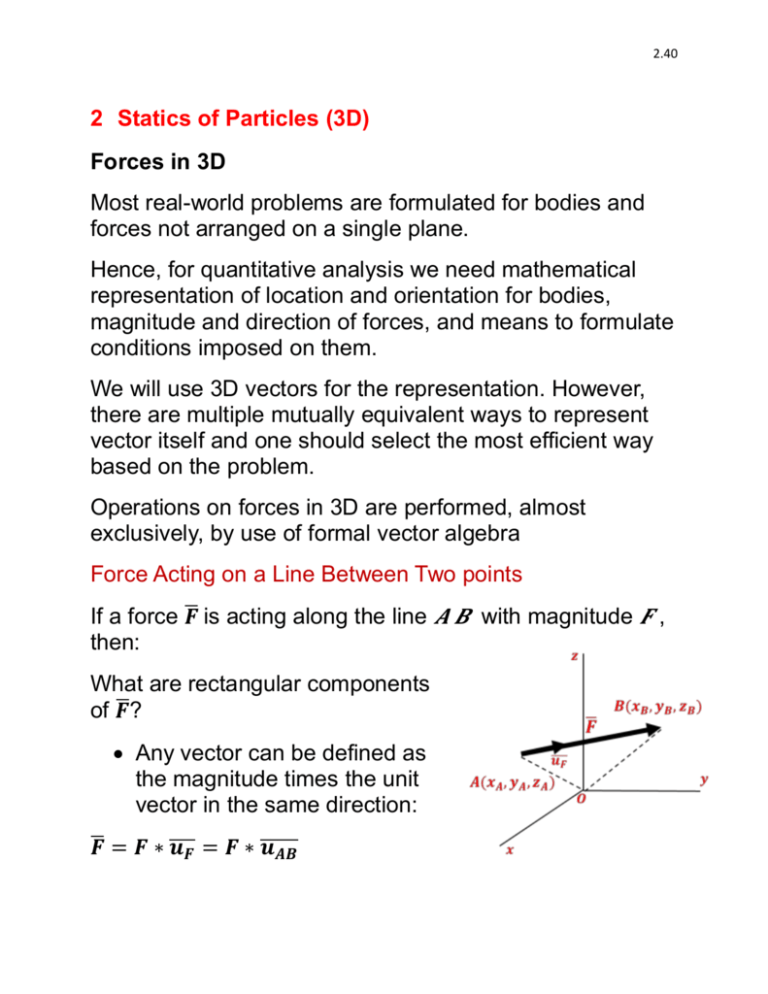
2.40 2 Statics of Particles (3D) Forces in 3D Most real-world problems are formulated for bodies and forces not arranged on a single plane. Hence, for quantitative analysis we need mathematical representation of location and orientation for bodies, magnitude and direction of forces, and means to formulate conditions imposed on them. We will use 3D vectors for the representation. However, there are multiple mutually equivalent ways to represent vector itself and one should select the most efficient way based on the problem. Operations on forces in 3D are performed, almost exclusively, by use of formal vector algebra Force Acting on a Line Between Two points ̅ is acting along the line 𝑨 𝑩 with magnitude 𝑭 , If a force 𝑭 then: What are rectangular components ̅? of 𝑭 Any vector can be defined as the magnitude times the unit vector in the same direction: ̅ = 𝑭 ∗ ̅̅̅̅ 𝑭 𝒖𝑭 = 𝑭 ∗ ̅̅̅̅̅ 𝒖𝑨𝑩 2.41 Unit vector in the direction of 𝑨 𝑩 : ̅̅̅̅ 𝑨𝑩 ̅̅̅̅̅ 𝒖𝑨𝑩 = |𝑨𝑩 ̅̅̅̅| Need to find the vector and vector magnitude of ̅̅̅̅ 𝑨𝑩 ̅ ̅̅̅̅ 𝑨𝑩 = (𝒙𝑩 − 𝒙𝑨 )𝒊̅ + (𝒚𝑩 − 𝒚𝑨 )𝒋̅ + (𝒛𝑩 − 𝒛𝑨 )𝒌 |̅̅̅̅ 𝑨𝑩| = √(𝒙𝑩 − 𝒙𝑨 )𝟐 + (𝒚𝑩 − 𝒚𝑨 )𝟐 + (𝒛𝑩 − 𝒛𝑨 )𝟐 Expanding to force components: ̅ = 𝑭 ∗ ̅̅̅̅̅ 𝑭 𝒖𝑨𝑩 = 𝑭 ̅̅̅̅ ∗ 𝑨𝑩 ̅̅̅̅ |𝑨𝑩| = 𝑭 √(𝒙𝑩 − 𝒙𝑨 )𝟐 + (𝒚𝑩 − 𝒚𝑨 )𝟐 + (𝒛𝑩 − 𝒛𝑨 )𝟐 Forces in 3D, Example 1: ̅] [(𝒙𝑩 − 𝒙𝑨 )𝒊̅ + (𝒚𝑩 − 𝒚𝑨 )𝒋̅ + (𝒛𝑩 − 𝒛𝑨 )𝒌 2.42 Example 2: Resultant of the sum of forces in 3D: ̅) = ̅ = ∑𝑭 ̅ = ∑(𝑭𝒙 𝒊̅ + 𝑭𝒚 𝒋̅ + 𝑭𝒛 𝒌 𝑹 ̅ (∑ 𝑭𝒙 ) 𝒊̅ + (∑ 𝑭𝒚 ) 𝒋̅ + (∑ 𝑭𝒛 ) 𝒌 Components of the resultant: 𝑹 𝒙 = ∑ 𝑭𝒙 , 𝑹 𝒚 = ∑ 𝑭𝒚 , 𝑹 𝒛 = ∑ 𝑭𝒛 Magnitude of the resultant: 𝑹𝒙 = ∑ 𝑭𝒙 , 𝑹𝒚 = ∑ 𝑭𝒚 , 𝑹𝒛 = ∑ 𝑭𝒛 Direction cosines: 𝒄𝒐𝒔(𝜶) = 𝑹𝒙 𝑹 ; 𝒄𝒐𝒔(𝜷) = 𝑹𝒚 𝑹 ; 𝒄𝒐𝒔(𝜸) = 𝑹𝒛 𝑹 2.43 Example: 2.44 Particle Equilibrium (3D) Similarly to a 2D situation, the EE are expanded to 3D: ̅=0 ∑ 𝐹̅ = 𝑭𝒙 𝒊̅ + 𝑭𝒚 𝒋̅ + 𝑭𝒛 𝒌 Or, if separated into components: ∑ 𝐹𝑥 = 0, ∑ 𝐹𝑦 = 0, ∑ 𝐹𝑧 = 0 Note: Three equations can be used to find 3 unknowns at most. Analysis of Equilibrium follows the same procedure as in 2D. 1. Draw FBD to include all acting forces. 2. Apply equations of equilibrium. In case of 3D there are three equations per particle. Hence, to solve them, there should be maximum 3 unknowns per particle. In 3D elimination technique is almost never used. Instead, use formal vector algebra. Possible unknowns: Force components / magnitudes / angles; some distances. Examples: 1 force – 3 components, or magnitude and 2 angles; 3 forces: magnitudes; etc. 2.45 Example 1: 2.46 Example 2: 2.47 Example 3: Example 4: 2.48 Example 5:
